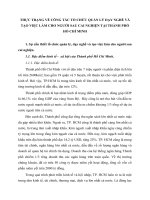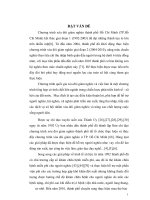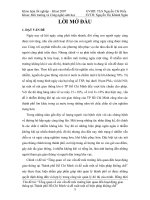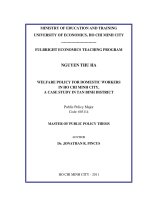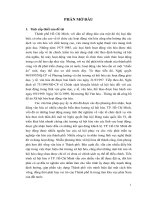Chính sách phúc lợi cho lao động nội trợ tại thành phố hồ chí minh
Bạn đang xem bản rút gọn của tài liệu. Xem và tải ngay bản đầy đủ của tài liệu tại đây (729.37 KB, 79 trang )
MINISTRY OF EDUCATION AND TRAINING
UNIVERSITY OF ECONOMICS, HO CHI MINH CITY
FULBRIGHT ECONOMICS TEACHING PROGRAM
NGUYEN THU HA
WELFARE POLICY FOR DOMESTIC WORKERS
IN HO CHI MINH CITY,
A CASE STUDY IN TAN BINH DISTRICT
Public Policy Major
Code: 603114
MASTER OF PUBLIC POLICY THESIS
ADVISOR
Dr. JONATHAN R. PINCUS
HO CHI MINH CITY - 2011
CONTENTS
CERTIFICATION i
ACKNOWLEDGEMENT ii
ABSTRACT iii
ABBREVIATIONS iv
LIST OF FIGURES v
LIST OF TABLES vi
CHAPTER 1 - INTRODUCTION 1
1.1. Problem statement 1
1.2. Research questions of the study 2
1.3. The object, scope and purpose of the study 3
1.4. Research Methods 4
1.5. The structure of the study 4
CHAPTER 2 - LITERATURE REVIEW 5
2.1. Relevant Concepts 5
2.2. Theoretical background 6
2.2.1. Demand for domestic workers in Vietnam 6
2.2.2. Supply of domestic workers in Vietnam 7
2.2.3. Theoretical background 8
2.3. Empirical studies 8
2.3.1. The number of domestic workers all over the world 8
2.3.2. The situation of domestic workers 10
2.3.3. Policies to protect the rights of domestic workers 11
2.4. Conclusion 12
CHAPTER 3 - RESEARCH METHODS 13
3.1. The purpose of the survey 13
3.2. Subjects of the survey 13
3.3. Survey sample size and sampling methods 14
3.3.1. Sample size 14
3.3.2. Methodology 14
3.4. Data collection instruments 14
3.5. Limitations of the survey method 15
CHAPTER 4 - SURVEY RESULTS 17
4.1. Characteristics of domestic workers 18
4.1.1. Gender of DWs 18
4.1.2. Age of DWs 18
4.1.3. Education 19
4.1.4. Family status 20
4.1.5. How DWs find jobs 21
4.1.6. Years working as domestic worker 22
4.2. DWs’ current job 23
4.2.1. Domestic chores 23
4.2.2. Working hours 24
4.2.3. Length of doing the current job 26
4.2.4. Working conditions 26
4.2.5. Income and expenditure 28
4.2.6. Health and Medical Care 30
4.2.7. Days off, leisure time and entertainment activities 32
4.2.8. Relationship with employers 33
4.2.9. Social contact 35
4.3. Legal awareness of DWs 36
4.4. Dishonesty of DWs 36
4.5. Conclusion 37
CHAPTER 5 - DISCUSSION 38
5.1. Irregular working hours 38
5.2. Problems adopting labor contracts 39
5.3. It is difficult to control issues relevant to DWs 40
5.3.1. Exploitation of domestic workers 40
5.3.2. Employers’ risks 41
5.3.3. The existence of child labor 41
5.4. “This is not a big problem” 42
5.5. Asymmetric information 42
5.6. Lack of the participation of labor unions in protecting DWs 43
5.7. Legal protections for domestic workers 44
5.8. Conclusion 44
CHAPTER 6 - POLICY RECOMMENDATIONS 46
6.1. Recommendations for employers 46
6.2. Recommendations for the Government 46
6.2.1. Support for establishing companies that provide domestic service 46
6.2.2. Issue the Decree guiding domestic services 47
6.2.3. Strengthen propaganda and education to improve legal awareness of laborers and
employers 47
6.2.4. Establish Unions to protect DWs 47
CHAPTER 7 - CONCLUSION 49
7.1. Conclusion 49
7.2. Limitations and distributions of the study 50
REFERENCES 51
APPENDIX 55
i
CERTIFICATION
I certify that I wrote this thesis myself.
I certify that the study has not been submitted for any other degrees.
I certify that any help received and all sources used have been acknowledged in this thesis
with the best of my knowledge.
The study does not necessarily reflect the views of the Ho Chi Minh City Economics
University or Fulbright Economics Teaching Program.
Author
Nguyen Thu Ha
ii
ACKNOWLEDGEMENT
I would like to express my deep gratitude to my parents and brother who always encourage me
in my life, my studying and my career.
I would like to express my sincere appreciation to my advisor, Dr. Jonathan R. Pincus, for the
continuous support of my study. With rich knowledge, experiences, patient, motivation and
enthusiasm, his guidance helped me in all the time of research and writing of this thesis.
Besides my advisor, I am grateful to Ms. Dinh Vu Trang Ngan for thoughtful and valuable
comments on the survey and the early version of my work.
I would like to thank to all teachers, librarians, laboratory assistants in Fulbright Economics
Teaching Program, who have helped and retransmitted a lot of their knowledge and experience
to me.
I am indebted to many of my relatives, classmates and friends in class MPP3 who supported
me to conduct the survey. This thesis would not have been possible without their assistances.
Last but not least, I would like to thank to all my friends, especially Ms. Nguyen Thi Thuy
Giang, Mr. Ta Viet Bac, Mr. Duong Tuan Anh, Ms. Nguyen Huong Giang, Ms. Dang Thi
Tuyet Nhung, Ms. Ngo Hai Thanh, Ms. Vo Thi Hoang Oanh, Ms. Nguyen Thi Hong Loan,
and Ms. Bui Thi Phuong Thao who helped and motivated me in performing the study.
Nguyen Thu Ha
Ho Chi Minh City – April, 2011
iii
ABSTRACT
This study analyzes practical issues about domestic workers in Ho Chi Minh City, which is
based on the theory that domestic workers today are working in bad working condition with
low wages, long working hour and face a range of exploitation, abuse, vulnerability and
discrimination.
We conducted a survey to examine the situations of domestic workers in Tan Binh District of
Ho Chi Minh City. We figured out that in this district the exploitation, discrimination and
sexual abuse exist but is not common. And because of asymmetric information, employers
become victims of dishonest domestic workers when they hire them. The market still lacks
companies that offer trusted domestic workers and organizations who act to protect domestic
worker welfare.
Therefore, the effective policy recommendations to better these situations are issuing realistic
laws to control this market accompanied by actions to implement it such as strengthening the
propaganda and education activities in poor areas, supporting the establishment of domestic
service companies, and the role of the Women’s Unions in propaganda to change perceptions
of both workers and employers.
Key words: Domestic workers, exploitation, abuse, vulnerability, discrimination, domestic
service companies, Women’s Union.
iv
ABBREVIATIONS
DWs : Domestic workers
HCMC : Ho Chi Minh City
NIS : National Institution of Statistic
ILO : The International Labor Organization
TBD : Tan Binh District
USA : The United States of America
v
LIST OF FIGURES
Figure 4-1: Gender of DWs 18
Figure 4-2: Number of DWs in groups of age 19
Figure4-3: Highest certificate of education of DWs 20
Figure 4-4: Family status of domestic workers 21
Figure 4-5: Job status of domestic workers' spouses 21
Figure 4-6: Years working as domestic workers 22
Figure 4-7: The length that domestic workers do the current job 26
Figure 4-8: Health of DWs in the sample 30
vi
LIST OF TABLES
Table 1-1: Subjects of the study 3
Table 3-1: Subjects of the survey 13
Table 4-1: How DWs are recruited 21
Table 4-2: Number of DWs provided work by a domestic worker supplier in the past 22
Table 4-3: Works in day of domestic workers. 24
Table 4-4: Working hours of domestic workers 25
Table 4-5: Working conditions of DWs 27
Table 4-6: Meals of DWs 27
Table 4-7: Income of DWs in the sample 28
Table 4-8: Expenditure of DWs in the sample 29
Table 4-9 : Reward for DWs on Tet holiday 29
Table 4-10: Bosses' treatment when DWs get ill 30
Table 4-11: Person who pays DWs medical expense 31
Table 4-12: Medical Insurance with DWs 31
Table 4-13: Agree with one day off in a week 32
Table 4-14: Activities of DWs at rest time 32
Table 4-15: How DWs use the telephone 35
1
CHAPTER 1
INTRODUCTION
1.1. Problem statement
The role of women in Vietnamese society is changing quickly. As women have entered the
labor force and set up businesses, demand for domestic workers (DWs) has become very large.
DWs have a big role in doing housework to ensure that the activities of the family can take
place smoothly. The domestic worker is also indispensable in household business.
Unfortunately, the growth of domestic service is accompanied by the widespread abuse of
labor, exploitation of maids, especially children. In many countries around the world,
including Vietnam, domestic work has not been regarded as a professional occupation and
there is no official legal framework to protect this workforce.
In Vietnam, especially in big cities, the shortage of DWs is a frequent topic of discussion.
Housemaids are a hot topic in the daily newspapers. Two prominent examples are the stories
of Nguyen Hao Anh in Ca Mau province and Nguyen Thi Binh in Hanoi. They were victims
of the inhumane torture over more than ten years at the hands of their employers (Huynh Hai,
Ngo Nguyen, 2010), (Huong Vu, Duy Hien, 2010). These cases shocked the public for a long
time and were a warning signal about the exploitation of domestic workers.
Currently, domestic service is not considered a formal job, and there is no specific agency
assigned to monitor and manage this group (Than Hoang, 2010). There are still no official data
on DWs, only case material about abuse and exploitation of DWs reported in the media. As
reported by the ILO in 2010 at the International Labor Conference, Manuela Tomei, Chief of
the ILO’s Conditions of Work and Employment program, Social Protection Sector said that
domestic work absorbs a significant proportion of the workforce, ranging between four to ten
percent of total employment in developing countries and up to 2.5 percent of total employment
in industrialized countries (ILO, 2010).
In Ho Chi Minh City (HCMC) in 2006, there were an estimated 2,162 children in domestic work
(ILO, 2006). In fact, children are a small part in this workforce, and the total is much greater.
2
DWs have common characteristics including their origins in poor families, low educational
attainment, and a lack of occupational skills. Their job is often doing housework or assisting
household businesses. They often do not have labor contracts, but only a verbal agreement
with employers. Between the employees and the employers, there are no legal obligations. The
consequence of this is that conflicts often occur. Because there is no basis for settlement,
workers are subject to unfair treatment or abuse. On the other hand, employers also have to
deal with the risks of dishonesty among DWs or other risks to their families.
The Vietnamese Labor Code recognizes domestic service as a profession and DWs have the
same rights and benefits as employees in other industries.
1
However, the legislation can
only be applied to those who have labor contracts. In fact, most DWs work under informal
arrangements. Both domestic workers and employers are not aware of this. Therefore,
interest in contracts and benefits of contracting are still limited. It is difficult for DWs to
protect their rights under the law.
Faced with this urgent situation, the government is preparing to issue a decree guiding what
should be done to protect DWs. The contents of the decree will focus on such issues as the
work of assistants, wages, working hours, working conditions, welfare policies and other
relevant issues.
Welfare issues for helpers are a topic of intense public interest and require timely intervention
to ensure the rights of workers. Motivated by this situation, the present research contributes to
providing a more practical basis for drafting the planned government decree on DWs, and
investigates ways to make the decree more feasible in its implementation.
1.2. Research questions of the study
This study attempts to answer two research questions as follows:
1. Why do DWs not have the same working conditions and benefits as employees in the formal
sector?
1
Labor Code of the Socialist Republic of Vietnam, June 23, 1994 as amended April 2, 2002, National Assembly.
2
“Snowball sampling” referred at
3
In order to answer this central question, some following sub –questions should be asked:
- What are the characteristics of DWs and their working conditions?
- What welfare policies are available to them?
- Are they receiving the benefits that they are entitled to?
- What are the major reasons that they do not receive equal treatment?
2. What should be done to improve the welfare of domestic workers?
1.3. The object, scope and purpose of the study
The subjects studied are listed in the table below:
Table 1-1: Subjects of the study
Objects / Job
Doing
house
work
Taking care of
children, the elderly
or the disabled
Assistant
for family
business
Part-time
domestic
workers
Girl under 15 years old
X
X
X
X
Boy under 15 years old
X
X
X
X
Women
X
X
X
X
Men
X
X
X
X
The study concentrates on the empirical facts of domestic work in Tan Binh District, Ho
Chi Minh City, and the perceptions of these DWs. Although we cannot assume that this
group is statistically representative of all DWs in the city, the intention is not to sample
systematically. We take Tan Binh District as a case that will help us to understand some of
the issues confronting DWs. Conclusions concerning the population parameters will have to
await a larger, city or nation-wide study, which is clearly beyond the scope of the present
paper. There are still no official data on DWs in Vietnam, only case material about abuse
and exploitation of DWs in the media. No specific agency has responsibility for monitoring
the situation of DWs. That is the reason why many contradictory opinions about this
problem exist. Therefore, the researcher will conduct a survey to collect data. The
4
interviews and data from the survey will be used to explore the real situation of DWs in
HCMC.
1.4. Research Methods
The study is based on a survey to examine the situation of DWs in Tan Binh District,
HCMC. The thesis first will analyze practical issues about DWs in HCMC. As noted above,
this is a small survey that cannot make generalizations about all of Vietnam, but is a form of
case study.
1.5. The structure of the study
The study consists of six chapters. This section belongs to the introductory chapter. Chapter
2 consists of a literature review providing relevant concepts and the theoretical and
analytical framework about the welfare of the DWs. Research methods are described in
Chapter 3. Chapter 4 consists of the results of the survey and the qualitative analysis of the
realities of DWs in Tan Binh District, HCMC. Based on this analysis, Chapter 5 discusses
the implications of the findings. Chapter 6 focuses on discussing policy recommendations.
Chapter 7 concludes and suggests topics for future research.
5
CHAPTER 2
LITERATURE REVIEW
2.1. Relevant Concepts
It is necessary to provide concepts which are relevant to DWs that are used in this study.
There is still no universal definition of DWs up to now. In fact domestic workers are often
called housemaids, house-help, or house girls. But they mostly perform the same duties in
the household (Akinrimisi, 2002).
According to Manuela Tomei, Chief of the ILO’s Conditions of Work and Employment
program, Social Protection Sector:
“Domestic workers may cook, clean, take care of children, the elderly or the disabled,
even domestic animals. DWs may work full- or part-time as wage workers for one or
more employers. They may also be self-employed with substantial control over the
terms of their work, or provide services in individual homes while being paid by
licensed institutions. DWs, especially full-time migrant DWs, may also live in the
employer’s home” (ILO, 2010).
This concept expresses most aspects of DWs, what they do, where they live, how much time
they work per day and per week, and how they get their jobs.
Domestic worker is an occupational title which should be “domestic service worker” and
means “the person managing household affairs as required for the household they serve,
including taking care of children, old people, the sick, etc” (Liu Minghui, 2009). Before that,
he defined the term domestic worker to mean any person who carries out household work
which refers to the services performed in or for a family, including household service, child
care, cleaning, cooking, home care, family education and other personal care, as well as taking
care of pets and livestock and tending to fields and gardens.
This thesis is about the welfare of DWs so it is also initial to provide the definition of welfare.
In daily life, it is a commonly understood term which implies mental and physical health,
6
living conditions and happiness. In the study, “welfare policies” for DWs means all policies
and activities relevant to DWs that bring them benefits which are besides the wage such as
medical care, social insurance, working condition
Besides these two terms, there are some relevant concepts that should be mentioned like
employer and household. An employer is a person on which the domestic worker is dependent
for staying in the household because he or she is the head of household or the responsible
person who hires and supervises the domestic worker. A household can be a single person or a
group of persons who live together, who may be related to each other, and who have common
arrangements for eating for at least three months in duration (NIS, 2004).
2.2. Theoretical background
2.2.1. Demand for domestic workers in Vietnam
With economic development, the demand for and supply of DWs increase quickly. Factors
which contribute to the increase in demand for DWs are demographic changes such as the
aging population, increasing participation of women in the labor force and the pressure of
family life in urban areas (D’Souza, 2001).
Vietnam is one of the countries which has the highest proportion of women in the labor
force (83 percent) (Tan Duc, 2011). Traditionally in Vietnam domestic chores are carried
out by women living in the household. When they expend more time in the labor force, the
time to do housework is reduced, therefore, they often employ DWs to replace them in the
kitchen or partly take care of their family.
The living standards of Vietnamese people are improving gradually and especially in urban
areas. The opportunity cost of doing house work is going up because people can get higher
incomes when working outside. Urban citizens can pay for DWs with wages that are lower
than their opportunity cost of time (Do Huyen My, 2009). Higher incomes allow them to
hire a domestic worker to do domestic chores for them.
One of main factors contributing to demand for domestic work is the aging population
(Bureau for Workers’ Activities-ILO, 2007). There are changes in family structure. Families
7
with two generations are replacing three-generation families. Young couples usually live far
from their parents and have to take care of their families and children themselves. And the
elderly need someone to care for them. These elements have contributed to rising demand
for DWs.
2.2.2. Supply of domestic workers in Vietnam
In Vietnam domestic workers are of varying different ages, but for the most part are
concentrated in the 15-25 and 40-55 year age groups (Ngoc Bao, 2010). The group 15-25
years old includes girls who have recently entered the labor market, who are unmarried,
who have migrated to the city but do not have enough technical expertise to be able to work
in other sectors. Women in the group 40-55 years of age are typically married and their
children are old enough to take care of themselves. They need money to pay for major
needs of the family such as children’s education or building a house. All in these two
groups have the same traits including origins in rural areas, and lacking in skills (Ngoc Bao,
2010).
DWs are almost all women who want to escape from poverty and who come from rural
areas (WIEGO, 2010). In these communities, there is a lack of employment opportunities.
In addition, students or other workers who have some free time and want to have extra
income also come into this sector as part-time employees. These factors are discussed in
detail below.
First, migration between rural and urban areas is now easier than before. Thus, people can
quickly leave the countryside and go to urban centers to find non-agricultural jobs with the
intention of improving their living standards. This is one of factors that increase the labor
supply for the city in general and the domestic labor supply as well.
Second, in cities, many students are willing to enter the labor market on a part-time basis.
They have some free time and they want to have more income. They want to have a job,
which does not require skills. That is why they want to be part-time DWs (Ngoc Cuong,
2009).
8
2.2.3. Theoretical background
One of the most important avenues for rural people to escape from poverty is wage labor.
Access to stable waged employment is a major motivation for rural people to migrate to
cities. However, women face discrimination in the labor market owing to a pronounced
gender division of labor, in which some jobs are considered “male” and other jobs “female.”
In addition, rural women are less likely to have educational qualifications required to get
better, more stable jobs. As a result, many rural women rely on the market for DWs.
Although this is unregulated, low-paid and inferior work, it is often a better alternative than
work available in the location of origin. However, because of their lack of alternatives, and
the informal nature of labor contracting, women in domestic work are subject to abuse and
exploitation.
2.3. Empirical studies
Housemaids have existed for thousands of years. In ancient traditions, every upper class
family and some middle class families used to have slaves or nannies to do domestic chores or
take care of the elderly, children or disabled people. In the modern, market economy
households hire DWs and pay for them. Many studies worldwide have shown that DWs still
do not have the same benefits as workers in the formal sector. They may be overworked,
treated unfairly, and some cases are subject to sexual abuse or violence.
2.3.1. The number of domestic workers all over the world
There are no credible statistics on the number of DWs worldwide. In many countries, they are
not considered as workers by national law and they often work in private homes that make it
difficult to find them and know about their lives. According to the ILO, domestic work is a
significant area of employment and it is estimated that there are over 100 million DWs
globally. Many of them are women and migrants (Williams, Tortell and Callister, 2009).
Especially widespread in the Middle East, the ILO estimates there are 22 million foreign DWs,
a third of which are women. They mainly come from Asian and African countries, including
Indonesia, the Philippines, Sri Lanka, Bangladesh and Ethiopia (IRIN, 2010) .
9
In Vietnam, the number of DWs is increasing quickly, both within the country and abroad.
According to statistics of The Bureau of Overseas Labor Management, from 2000-2009,
Vietnam sent 231,708 female workers overseas. Taiwan is the top receiving country (61
percent), while 21 percent went to Malaysia and up to four percent to Macao. Women laborers
working as DWs accounted for 51 percent (Ngoc Bao, 2010).
Indonesia ranks among countries with the highest number of DWs worldwide. According to
the National Network on DWs Advocacy of Indonesia, it has 10 million DWs within the
country and six million abroad. Many of are subject to abuse and mistreatment. Sam Zarifi,
Amnesty International’s Asia Pacific Director of Indonesia, said that about 2.6 million
Indonesian DWs lacked access to legal protection (Jakarta Post, February 16, 2011).
The situation is not very different in China. In recent years, the domestic service industry in
China has grown very rapidly. Nearly 20 million DWs are employed in the domestic service
sector. However, the population of children under 14 years of age accounts for 20 percent of
urban residents, and fifteen percent are above 60 years of age. Therefore, the demand for
domestic service has the potential to grow much more (Liu Minghui, 2009).
In India, domestic service makes up one of the country’s largest labor categories, behind only
farming and teaching (Wax, 2008). India’s National Domestic Workers’ Movement has more
than 3.5 million members (Theckanath, 2010), and the total number of DWs is estimated to be
much higher.
In industrial countries, the need for DWs has also grown with the rise in the population,
because there are more and more elderly, and children need to be looked after by someone
who replaces parents for part of the day. In France, in 2006, there were 2.5 million private
individuals employed as DWs. A study by the Dutch trade union federation estimates that
about 240,000 DWs are illegally employed in the Netherlands. And in Switzerland, there are
more than 30,000 DWs. The number of DWs in New York City, USA is estimated at 200,000
people and is 600,000 in New York state. In Africa, the poorest continent of the world, there
are also about one million DWs in South Africa (Bureau for Workers’ Activities-ILO, 2007).
10
To sum up, the statistics above show the huge number of DWs all over the world. However,
little research has been done on their conditions of life and work, and the policy implications
of maintaining such a large and unregulated sector of employment in both developing and
industrialized countries.
2.3.2. The situation of domestic workers
A Human Rights Watch report published in April 2010 said about domestic workers in
Indonesia:
“Domestic workers faced a wide range of abuses. Many experienced poor working
conditions, such as needing permission to leave the house, a lack of leave days,
having their passports taken away and, in some cases, physical and emotional abuse”
(IRIN, 2010).
The report also noted that access to justice was limited. Simel Esim, a gender expert at the
ILO in Beirut, said this situation is because domestic labor is in the home and considered as a
private matter. They are dependent on the employer. It is a challenge to monitor their lives in
the employer’s house (IRIN, 2010).
In Ho Chi Minh City of Vietnam, many DWs are children. Most of them live in their
employers’ houses. They have to work from 13 to16 hours a day, with low wages, no days off,
depending on employers. They often cannot get in touch with their families, and are cut off
contact with the outside world. If they intended to have a boyfriend or husband they are fired
(ILO, 2006). It is similar to the situation of child domestic workers in Cambodia (Cambodia
National Institute of Statistics, 2003), and Indonesia (Human Right Watch, 2009).
Mistreatment and abuse of DWs is a consequence of the lack of knowledge of these DWs
about their rights and how to protect themselves. A study of DWs in Thailand concludes:
“There are limitations in terms of scope of protection extended to DWs and the actual
implementation of such protection. In most cases, both the employers and DWs
themselves are not aware of their duties and rights under the Labor Protection Law.”
(Boontinand, 2010).
11
If DWs understand their rights and try to realize them, they can have the rights as workers in
other formal sectors. In USA, DWs had no rights to organize under the National Labor
Relations Act and the civil rights laws did not protect. In 1974, the US labor law was changed
to cover DWs. The result was a remarkable improvement in their lives. By forming a
Domestic Workers Union nationwide, they have nearly won their rights under a new Domestic
Workers Bill of Rights that has been proposed in the US Senate (ILO, 2010).
2.3.3. Policies to protect the rights of domestic workers
For many years, in many countries, domestic service is not considered as a professional
occupation. Therefore, many DWs are not protected by legislation.
The Vietnamese government has planned to issue a decree including guidelines for
activities relevant to domestic work aimed at realizing the rights of DWs. If fully
implemented, this may ultimately lead to an integrated social security system for all DWs.
In Indonesia, DWs have been discriminated against under the 2003 Law, and up to now
they have not received legal protection compared to workers in other sectors. But the draft
law on domestic worker protection will be debated in 2011 (Jakarta Post, February 16,
2011).
The international community today has recognized that DWs have rights comparable to other
workers (Theckanath, 2010). Many previous studies have shown that countries worldwide
have taken positive action to guarantee rights of DWs. Governments which are members of
the ILO have to follow the international labor standards approved by the ILO. A proposed
ILO Convention to cover DWs worldwide is due to be debated in June 2011 (IRIN, 2010).
Efforts to protect the rights of domestic worker differ from region to region. For example, in
Latin America, many activities to protect DWs have implemented. In Brazil, the first
organization of DWs was formed in 1936 in São Paulo, and Article 7 of the Constitution
adopted in 1988 provides protection for their right to do so. In Uruguay, the establishment of
the new tripartite wage board composed of government, employers’ and workers’
representatives also brought together organizations representing DWs and their employers
12
(ILO, 2010). In November 2010, after a workshop in Beirut, Lebanon, Arab trade unions
agreed on a statement of principles, including the right to decent wages and union
representation for foreign DWs. In 2009, Lebanon's Ministry of Labor approved a standard
contract for DWs that specifies a maximum 10-hour workday and a minimum of six days of
annual leave, among other provisions (IRIN, 2010). In March 2010, Syria introduced a law
requiring employment agencies to register with the government (IRIN, 2010). Jordan has
comprehensive labor legislation covering foreign DWs (IRIN, 2010).
2.4. Conclusion
This chapter has reviewed the literature relating to the demand for and supply of domestic
service. Furthermore, the chapter also pointed out empirical studies of DWs.
All studies agree that domestic service labor is an important part of the labor force in most
countries in the world. Most DWs are not protected by national law. They often work in
difficult conditions, face risks of vulnerability, discrimination and even some of them are
subject to violence or sexual abuse. Governments and trade unions around the world have
taken action to protect them but it seems to be that their equal rights is still far from achieved.
This chapter has provided the theoretical and practical framework for this study to analyze the
situation in Vietnam. Bases on this framework the study will focus on issues about the detailed
situation in Vietnam as follows:
- Characteristics of DWs;
- Working conditions of DWs;
- Welfare policies which are available for DWs;
- Efforts to improve DWs’ lives.
13
CHAPTER 3
RESEARCH METHODS
As mentioned above, this study is based on a survey to examine the situation of DWs in
HCMC. Empirical information is derived from a case study of DWs in Tan Binh District
(TBD). Based on this case study, the thesis analyzes practical issues about DWs in HCMC.
3.1. The purpose of the survey
The survey has two main objectives. The first is to discover all aspects relevant to DWs’ lives
such as personal traits like family information, education, health; working experiences;
working condition and living environment; income; carreer development; awareness of laws
and regulations; relationships with their employers and with society. Each of these topic forms
part of the questionnaire used in this study (the questionnaire is included as Appendix 1, 2, 3 to
this thesis).
The second objective is to provide policy recomendations relevant to protecting the rights of
DWs in the future.
3.2. Subjects of the survey
To achieve the objectives stated above, the main subjects of the survey are DWs in HCMC.
They are divided into the following groups.
Table 3-1: Subjects of the survey
Subjects / Job
Doing house
works
Taking care of
children, the elderly
or the disabled
Assistant
for family
business
Part-time
domestic
workers
Girls under 15 years old
X
X
X
X
Boys under 15 years old
X
X
X
X
Women
X
X
x
X
Men
X
X
x
X
In addition, some employers and relevant officials have been interviewed to provide a
background about DWs and broader perspective on the issues.
14
3.3. Survey sample size and sampling methods
3.3.1. Sample size
TBD has over 75,000 households. It is administratively divided into 15 wards. With the aim
of collecting new stories about DWs as much as possible, the original sample size was: 50
DWs, 20 employers, 5 community officials.
3.3.2. Methodology
Snowball sampling (chain referral sampling) is used in this survey. Snowball sampling is a
non-probability sampling technique that is used to identify potential subjects where subjects
are hard to locate. DWs are this kind of subject. They are often unregistered. The initial
subject is introduced by researcher’s acquaintances. The process of snowball sampling is
like asking previous subjects to nominate another person who have the same trait as the next
subject. After interviewing the initial subject, the researcher asks him/her to introduce the
researcher to people with similar traits and interest. Then the researcher observes the
nominated subjects and continues the process in the same way until the expected number of
subjects has been attained.
2
In fact, the survey can be stopped when the interviews no longer contribute new information
or add value to the study (Seidman, 2006). Therefore, the interviewer decided to stop the
survey after surveying 40 DWs in TBD, 13 DWs in other districts, 14 employers and 5 ward
officials.
3.4. Data collection instruments
This survey applied the qualitative method and three questionnaires were used.
Domestic worker questionnaire: to collect information about DWs including family status,
education, healthcare, working and living condition, awareness about their job, wage and
leisure time.
2
“Snowball sampling” referred at
15
Employer questionnaire: to find out employers’ perceptions of domestic service, attitudes
and treatment of their DWs.
Questionnaire for ward officials: to discover how local officials perceive the domestic
worker issue.
3.5. Limitations of the survey method
Snowball sampling is a form of non-random sampling. The results of the survey are
dependent on the understanding and relationships of the interviewer. Thus, the results will
be affected by subjective perceptions of the researcher. It is difficult to estimate the error of
information collected so that we cannot make generalizations about all of HCMC or
Vietnam on the basis of these results. However, when other sampling methods are difficult
to use, this is the best sampling method to collect information about the real situation of
DWs.
The disadvantage of this technique is the potential for sampling bias. Specifically, the
helpers who were interviewed were mostly maids in households of officials and public
servants or office workers, who are highly educated, knowledgeable about the law and the
rights of workers and for the most part respectful of maids, treating them like members of
the family. Some maids were interviewed randomly as the researcher met them on the way
to conduct interviews. These were mostly assistants in the small restaurants whose owners
are kind people. They allow their employees contact with people from outside freely so that
the researcher could approach and interview them.
The topic of this study is a sensitive issue in society today. It relates to attitudes and
behaviors about human relationships. In general, people do not want others to think badly of
them. Therefore, people tend to conceal behaviors or attitudes that are not socially aware or
acceptable. Domestic workers are afraid to speak truthfully about their situation because
they are afraid of losing their job.
In addition, due to time limitations, in such a short time of the interview, the domestic
worker could not develop sufficient trust in the researcher to share information of a private
nature, especially sensitive problems in their relationships with their employers. Thus the

